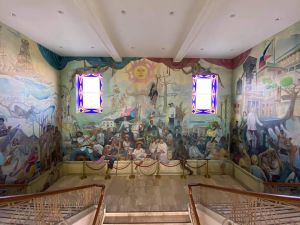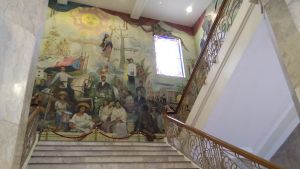Malolos Mural
Article by: Francesca_E
Definition of a Mural
A mural is an artwork created directly on a wall or ceiling; the word "mural" is an adjective from Spanish that means "attached to a wall." The term "mural" dates back to the 20th Century. Artists can create it using various methods, including oil paint on canvas, liquid silicate, ceramics, fresco, encaustic painting, and tempera painting, just like other works of art.
Who is Amadeo Manalad?
Renowned artist Amadeo Manalad painted the giant mural, beginning his production of works of art at an early age. Manalad brightened the drab walls where Philippine history is on exhibit with his magnificent artworks with his golden hands. He created a variety of scenes, including landscapes and seascapes. The giant mural in the Philippines, "Kasaysayan ng Bulacan," is situated in Malolos.[1]
The "Kasaysayan ng Bulacan" Mural
The giant mural, "Kasaysayan ng Bulacan," was painted on plywood using oil by renowned muralist Amadeo Manalad in 1976. They put up the vast mural to honor Marcelo H. del Pilar's 126th birth anniversary on August 30, 1976.[2] Due to its size, measuring 23 feet by 74 feet, people regard it as the most giant mural from the past. You can see this stunning and massive mural from the stair rails of The Gat Blas F. Ople Hall in Malolos, Bulacan.[3]
The painting honored our nation's brave warriors. It marked the residence of the "Pambansang Alagad ng Sining," or National Artists, who significantly contributed to the arts in music, dance, theater, architecture, and other media. Furthermore, the masterpiece depicts how vibrant Bulacan is by showcasing well-known customs such as fiestas. After renovations at the Bulacan Capitol around 1991, they moved the artwork to the Hiyas ng Bulacan Cultural Center before returning it to the building in 2018.
The "Kasaysayan ng Bulacan" Mural is a massive mural that depicts in one large piece the various people, places, customs, and civilizations of the Bulacan Province and the Philippines during the Pre-Colonial Period. There are three panels in the mural, and each one tells a tale. The mural's left side depicts the Spanish, American, Japanese, and Filipino colonists trading with foreign merchants as the Philippine colonizers. The mural's central section defines several notable Bulakenyos over the ages. The mural's right portion illustrates Bulacan's development.[4]
References
- BULACAN: A cradle of heroes and artists. (n.d.). Manila Bulletin. Retrieved October 23, 2023, from https://mb.com.ph/2021/2/24/bulacan-a-cradle-of-heroes-and-artists
- Caloy, W. (October, 2011), Malolos City: Bulacan’s Mural of History - Wandering Caloy http://wanderingcaloy.blogspot.com/2011/10/malolos-city-bulacans-mural-of-history.html ?m=1
- Facebook. (n.d.). Www.facebook.com. Retrieved November 6, 2023, from https://www.facebook.com/PhactoBHH/posts/173836181012160/
- October 19, 2016. (2016, October 19). Places You Must Visit in Bulacan. https://beautimarkspotmalolos.wordpress.com/2016/10/19/
- ↑ https://www.facebook.com/PhactoBHH/posts/173836181012160/
- ↑ http://wanderingcaloy.blogspot.com/2011/10/malolos-city-bulacans-mural-of-history.html
- ↑ https://mb.com.ph/2021/2/24/bulacan-a-cradle-of-heroes-and-artists
- ↑ http://wanderingcaloy.blogspot.com/2011/10/malolos-city-bulacans-mural-of-history.html


